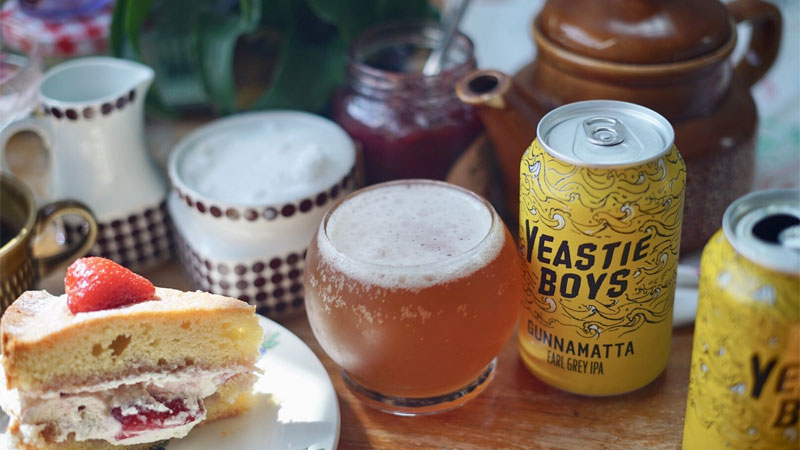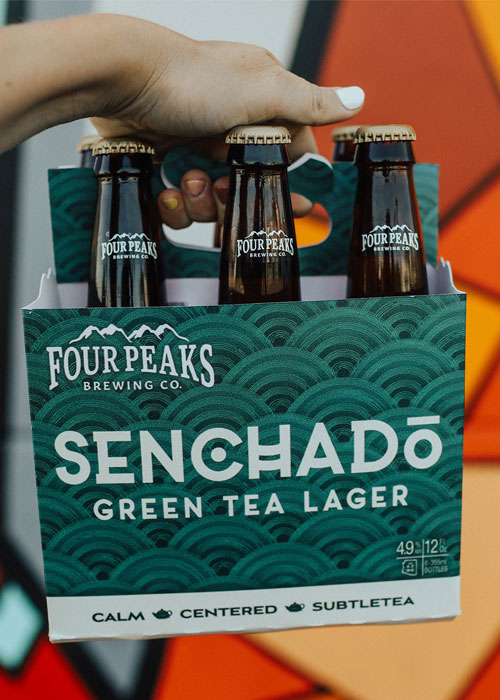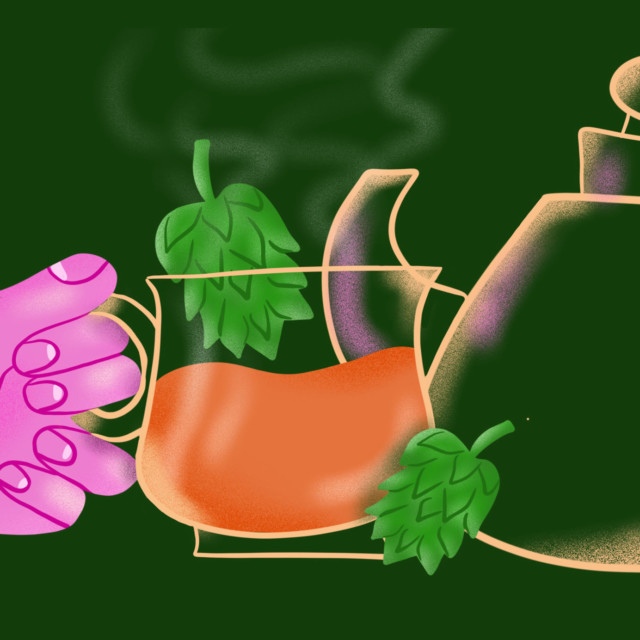Most classic beer styles can be brewed using only the four traditional beer ingredients: water, malt, hops, and yeast. But stepping away from the Reinheitsgebot-approved components doesn’t always mean reaching for the closest fresh-baked confection to make a donut-laden pastry stout; nor does it require packing in pounds of fresh fruit purée for a thick, smoothie-esque mouthfeel. Sometimes, a subtle flavor enhancement is all a beer needs to bring a fresh perspective to homebrewing — and for a growing number of brewers, that can come in a variety of tea leaves.
Tea — green tea, black tea, or even Earl Grey — can bring a wide range of mild natural flavors to various beer styles. And with more commercial examples hitting store shelves in recent years, homebrewers can take inspiration from beers out on the market.
Brewers from Yeastie Boys, Four Peaks Brewing Company, and Bonfire Brewing, explain the techniques for making tea-focused beers that can range from refreshing, to earthy, to nostalgic. Sometimes that means pitching full tea leaves into a batch of beer; other times it means cold steeping a tea concoction before adding it to the final product.
Whether you’re looking for the earthy complexity of a matcha latte, or craving a thirst-quenching homebrewed Arnold Palmer, here are three brewers’ tips for working tea into your homebrew repertoire.
What Flavors Can Tea Contribute to Homebrew?
Stu McKinlay, founder of Yeastie Boys Brewery founded in Auckland, New Zealand, says he was inspired to brew Gunnamatta, his brewery’s signature Earl Grey-infused IPA because he realized the tea had similar flavors to the hops grown in the United Kingdom. (Yeastie Boys has added operations in Australia and the U.K.) “I always associated leafy English bitter [ales] with the aromatics of tea,” he says.
Using Earl Grey to enhance some of those herbal and fruity flavors was natural to McKinlay. He says the flavor profile of Gunnamatta is “boldly floral — much like your granny’s bedroom — with stone fruit, citrus and a long, dry finish.”
Just as nostalgic as Granny’s bedroom, the team at Bonfire Brewing in Eagle Rock, Colo., was looking to recreate the taste of a favorite summer drink in their new Arnold Palmer-inspired beer, “Bon Daly,” a blonde ale with black tea and lemon. Lead brewer Dylan O’Malia uses black tea and lemon to get those memorable flavors into the body of a light, easy-drinking beer.
As the innovation brewer at Four Peaks Brewing Company in Tempe, Ariz., Melissa Osborne gets to experiment with all kinds of novel ingredients. “I like savory flavors more than sweet, so I really like to play with spice blends and different teas for new beers,” she says.
Osborne has made several tea-flavored beers, and Senchado Green Tea Lager is one her most popular creations. At Four Peaks, the innovation beers are typically only available on draft in the taproom or in kegs around the Tempe area, but Senchado was packaged and released for distribution as a seasonal beer because customers loved the smooth and subtle earthy notes of sencha green tea in the beer, Osborne says.
Osborne has also used other teas with floral and tropical notes. She is currently working on a lager using rose hip tea this summer.

Building a Recipe for a Tea-Infused Beer
In order to showcase the most nuance of the tea flavor, a simple grain bill is required.
Both O’Malia and Osborne focus on keeping the malt flavors light, choosing a grist that will just add a touch of malt flavor from a small addition of Vienna or Munich malt as well as a little Carapils/Carafoam for body. The rest of the grain bill is pilsner or another light malt.
“I kept it really simple in order to not mask the flavor of the tea,” says O’Malia.
McKinlay is more focused on keeping the hop additions in his recipe from overwhelming the tea flavors “We use a small dose of Centennial, Cascade, and Huell Melon in the kettle and whirlpool,” he says, “just enough to lift that character above the threshold level and add nuance and a depth of flavor.” He adds that Gunamatta has no dry hop addition, so that hop aroma won’t interfere with the fragrance of tea.
What to Watch Out for When Making Tea-Infused Homebrew
Tea contains tannins — the same drying, harsh compounds contained in the husks of malt — so it is important to take care of the delicate leaves in order to avoid extracting too many tannins into the final beer.
McKinlay says, “Gunnamatta is essentially an American-style strong pale ale, but we cut back the bitterness by about 25 percent, compared to what we’d do as a hopped beer, to account for the fact that the tea adds a distinctive drying character.”
Beyond accounting for the amount of bitterness tea will add, it is crucial to pay attention to how the tea is handled to avoid tannin extraction. “Homebrewers just need to be careful of getting the tea too hot and becoming astringent,” says O’Malia, who has brewed two different types of tea-infused beer at Bonfire.

When to Add Tea to Homebrew?
Tannin extraction is one of the most critical considerations when determining how to add tea to your homebrew. The tea can be added on the hot side of brew day (during any step before the wort is chilled), or the cold side (typically after fermentation is complete). If a brewer decides to add tea ingredients on the hot side, the tea is added to the whirlpool. Some tropical teas that are lower in astringent compounds, such as hibiscus, are sometimes added to the boil to extract more of vivid magenta color, but this isn’t common.
During Brew Day
It’s tempting to think tea would be added in the boil kettle with the hops, but for most tea varieties this exposure to hot wort would be too long. Especially for black teas, extended time at boiling temperature extracts astringent compounds that give beer a harsh mouthfeel. For any tea, lengthy boiling would blow off most of the complex aromatics. Instead, tea should only be added after the boil during the whirlpool.
This ensures the tea won’t be in contact with wort for too long, and keeps tea leaves out of the fermenter as they will be left behind with trub in the whirlpool.
O’Malia adds black tea leaves to his Arnold Palmer beer during the whirlpool at a rate of 0.5 ounces per gallon.
After Brew Day
To avoid any exposure to hot wort, tea can be added to beer after fermentation.
McKinlay gets the tea flavor into his beer using a method similar to dry hopping. “We add the tea to the fermenter at the end of fermentation, so in effect we are creating a ‘dry-leafed’ ice tea-[flavored] beer.” He adds tea leaves directly to the fermentor at a specific rate of 400 grams per hectoliter (roughly 0.5 ounces per gallon). Since Gunnamatta is one of Yeastie Boys’ core beers, McKinlay knows the exact amount of tea that should be added to the beer before it is filtered out and the beer is packaged.
Homebrewers won’t have their exact measurements dialed in for their tea addition, which is the situation Osborne is in when she is brewing new beers at Four Peaks.
“I would suggest they [homebrewers] get a French press, and try different tea infusions,” she says. Tea can be steeped overnight in cold beer in a French press, then sampled to ensure the brewer likes the flavor the tea is imparting and the intensity of it. She says steeping the tea cold has resulted in the most tea aromatics and flavor with the least bitterness (instead of brewing it hot like a typical cup of tea is made).
Once you find a tea intensity you like, she suggests making the cold infusion in a separate vessel and then adding that to the fermenter or carboy to get the tea flavor in the final beer. This avoids two complications: First, tea leaves bloom and soak up beer which would result in losing some of the homebrew in the leaves left behind in the fermenter; second, “You can add the infusion a little at a time so you’re not overdoing it,” says Osborne, “because you can always add, but you can’t subtract [the tea flavor].”
And with that, a whole new world of tea-infused brew days is ahead. From warming, chai-flavored stouts, to tropical hibiscus-steeped blonde ales, or even herbaceous green tea saisons, having a grasp of the best ways to use this ingredient opens up countless homebrew opportunities.
